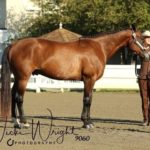“There was a pony named Barbapoppa that I received at the age of five, and he was very mischievous and maybe even devilish. Barbapoppa was the most fabulous first animal I was to have and challenged me much.”—Chantal Sutherland, Canadian model, television personality, North American Thoroughbred horse racing jockey, and touted as the Danica Patrick (Indy/NASCAR driver) of horse racing.
Off the Track—On Just Being a Horse

In western Pennsylvania, near The Meadows around 2008, Julie Allison-Goodell, owner of Chestnut Lane Farm, opened her turnout facility for Standardbred racehorses.
Turnout facilities are essential for successful harness racing and meet the needs of recreational-downtime to simply–be a horse.
Turnout is an interesting accommodation. Typically, racehorses are kept ever-impeccably clean and “groomed to perfection,” with every hair brushed and coiffed in place. At training facilities, horses lounge in straw-bedded stalls, under the breeze of a personalized fan, and listen to tunes.
In contrast, at turnout, Pennsylvania’s racehorses do as they choose in lush, grassy, grazing pastures. Given their druthers, shiny coated racehorses, enthusiastically paw up dust-bath pits and then . . . get down and grungy.
The horse lowers first onto one side, rolls, and rubs, stands, and then lies down on the other side and rolls and rubs again. All traces of menthol-scented shampoos, aloe Vera conditioners, bee’s wax hoof dressings, and the like are diminished, removed, and replaced with essential earth.
It’s a communal activity that is a world-wide, equine phenomenon. The ritual is practiced by Triple Crown winners to harness racing derby winners to children’s backyard Welsh ponies to feral and semi-feral Nokata horse “mustangs” in North Dakota. Once the grunge-deed is done, grass-gorge grazing or stretching flat-out on the grass for sunbathed snoozing is the order of the day.
From these therapeutic mini-vacations at turnout facilities across Pennsylvania, such as Chestnut Lane Farm, racehorses return refreshed and eager for the starting gate.
On the Track—An Opportunity Presents
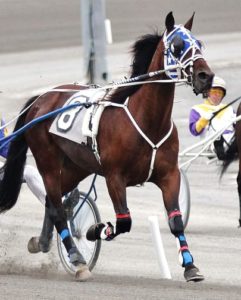
In 2011, on one of Julie Allison-Goodell’s frequent trips into the The Meadows stable area, a remarkable and gorgeous Standardbred trotter named Investor caught her eye.
“I’d show up with my trailer to load up a horse and take it to the farm for 4-5 days and then bring ’em back. I saw a pretty handsome horse named Investor. A while later, I heard he wasn’t racing well, so I asked if he was for sale,” shares Allison-Goodell.
“He wasn’t. They said that they wanted to try one more time. They finally called and said, ‘If you want the horse, we’ll sell him to you.’ Back then, the Amish price was $2500.00, and that’s what I paid for him. I took him to my blacksmith and said, ‘Let’s see what we can do.'”
Misbehaving Horse Games Drivers
“In truth, I didn’t know if I was buying a riding horse or a racing horse. I worked to get him extra healthy and took time to get him race-ready. He is super intelligent, but not a pleasure to drive on the track. He pulled and was a bit hard to deal with,” says Julie Allison-Goodell.
With professional trainers and warmup drivers, Investor calculated his mischief to have fun. As Julie Allison-Goodell describes it. “He was eight when I got him. He was a little bit of a jerk on the track. I had a couple of warmup guys I’d hire to warm him up before the race. Investor could smell fear. There even was this guy who does harness racing for a living. He has twenty head of horses, and is 1,000 percent capable of warming up a horse! He’d give that man a wild ride too. Investor was determined to have his fun.”
Confides Julie, “Investor would very calmly and slowly walk out onto the track. He’d have his head down and stretched and relaxed like a western pleasure horse. When the warm-up driver would ask him to trot, Investor would nod his nose out and pull out the driving lines longer. He was testing for resistance. If the driver did not have his hands in the tugs, Investor would tuck his head into his chest [avoiding the bit and eliminating any driver control]. Then, he’d take off speed-trotting.”
“If he could smell the fear, he would get the driver so rattled! The driver would end up with his wrists up though the handholds, his foot braced up on the crossbar, and pulling to get control. With some guys, it became an incredibly fun game for Investor.”
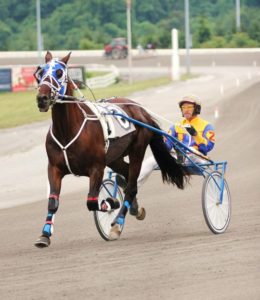
“I broke him to ride,” says Goodell-Allison. “He was always good to ride and even represented the Standardbred breed at equine events in jog carts. There, he’d be fine. That was the only place I’d drive him. I’d do cones in the indoor ring—fine. If I only had to drive once a week at the track, it’s not bad. But take him to the track, and he’d get mischievous. He only clowned around when we went to the track. He made a reputation for himself. He was like that known naughty pony in the neighborhood that would buck off every kid.”
“Also, harness racing tracks are harder surface than the deeper Thoroughbred tracks, and if a horse misbehaves on the track, I wimp out,” confides Allison-Goodell.
“The entire time I raced him to all his wins, he raced with the same driver–Brian Zendt. They had a great partnership. Brian understood how to navigate Investor’s personality. They got along very, very well. Really exceptionally well.”
Curing Boredom
“Strength lines in differences, not in similarities.”—The Seven Habits of Highly Effective People by Stephen R. Covey
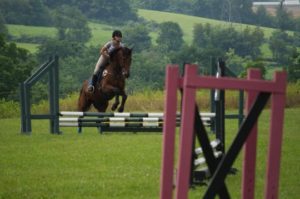
Cross-Training
“Years ago,” says Julie Allison-Goodell, “I was the day help at this training barn. I was working with a small, 14.2 horse. He had “little man syndrome” and a bit of a reputation. When you went to hook him to warm up or to race, he’d bounce up off the ground and raise, threatening like he was going to rear. He wanted you to think he was a badass. He’d fake a threat to bite, and turn at you with his mouth wide open.
This one day, I was at his side, readying him to go out. He turns like he’s going to bite me, except he actually has taken my whole arm in his mouth!
The look on his face was priceless, because he suddenly realized, ‘Oh goodness, this girl’s arm is in my mouth. Uh no! I have her arm in my mouth!’ And he freezes and slowly backs his mouth off my arm with this expression like, ‘Sorry, I gotta little carried away there. Uhh… sorry. Uhh, I didn’t mean to scare you! Oh, man, I gotta remember: Eating the help is strictly forbidden’!”
Understanding Intelligence
Julie Allison-Goodell believes, “Horses are smart, and if you think about what a Standardbred racehorse traditionally does, it’s got to get boring. From their perspective, think about how many times they stand around hanging out in the stall for twenty-some hours-a-day. Then it’s out and jog around the same track, get bathed, and groomed. It’s got to be boring, especially for intelligent horses. Eventually, the super-smart, intelligent horses are going to find ways to entertain themselves.”
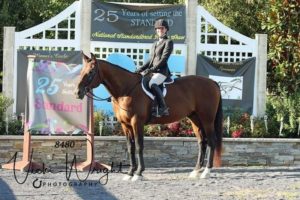
“Investor’s intelligence is really apparent. So, since I come from a riding background, I started riding him in the arena and out on trails as a solution for his daily racing workout. He only went to the track to train a bit and to race. He did well that way. I bought him as an eight-year-old. I raced him for six years, and won 19 races out of his 34 lifetimes wins,” shares Allison-Goodell.
Cross-competitions
Says Allison-Goodell, “Eventually, I thought, ‘well, if I’m going to ride this horse every day, I’ll take him to some horse shows.’ We did a little work over fences, and he learned to jump. We’d do dressage clinics and hunter paces.”
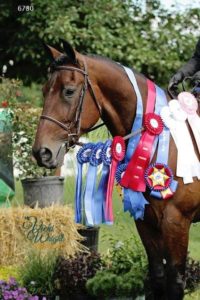
“So the entire time I was racing him, he was doing other riding and driving events. He represented the Standardbred horse breed at Equine Affaire in Columbus, Ohio. There, I had to get up early and work him to keep him in shape for racing because he was in the petting stall throughout the open event hours. Together, we participated in the dressage clinics and in doing the Equine Affairs breed demos. The event itself is like a large trade show with a portion dedicated to different horse breeds. It’s a large event for horse enthusiasts,” says Allison-Goodell.
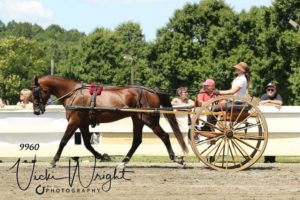
“He enjoyed the variety, always watching events and goings-on with his head out the stall. At Equine Affaire, there are different clinics and fifteen-minute breed demonstrations in the arena spaced throughout the day. You go in and ride or drive, and the announcer reads a script about the breed read over the PA system,” reminisces Allison-Goodell laughing. “All through that, Investor was in for Tuesday to race at The Meadows!”
“So, to do well in that environment while keeping him at his peak to race, I’d get up early and jog him for 30 minutes a day because I knew he wouldn’t be ready otherwise. We were doing his race-work training and conditioning and doing his PR work. That year New Vocations sponsored several Standardbreds to represent the breed,” says Allison-Goodell.
“We’ve also represented the Standardbred breed at the BreyerFest model horse festival at the Kentucky Horse Park in Lexington, Kentucky. Kids really enjoy coming through the barn and seeing real horses. A lot came through that had never gotten to interact with a real horse (like kids coming from NYC). Investor was great with the commotion.”
Building Core-Muscles
“When I bought Investor in September of 2011, I only had him for a couple months before I started working him under saddle, on trails, in the arena, and over jumps,” says Julie Allison-Goodell. “It met the needs of his ever-active mind and sculpted his body. When you look at pics a few years later, his body shape and muscling is completely different. When I got him, he didn’t have a top line. His whole top line developed behind his withers and his butt muscled with all that variety of work. He was still racing, so he wasn’t fat or overweight. Looking at different years’ photos, you see in the photos how his body changed over time.”
“The last year that I was combining racing and showing him, he looked just as good as a horse can look. All those other muscles got built under saddle, muscles that simply don’t get built from trotting. A horse trots from their legs. They don’t trot through their bodies, and so they are lacking core-strength muscles.
In photographs, you can see the difference over time the work did for his body development. He’s been retired from racing for a few years now.”
From Track to Farm and New Careers
For owners from The Meadows with a horse that they want to guarantee a solid start in their next career, Julie Allison-Goodell provides vital retraining services. Says Allison-Goodell, “Almost every horse I raced, I trained to ride. Our vet thinks it’s especially good to do hill work.”
“Standardbreds are interesting. I’ve been lucky because a lot of the horses I broke for owners, the owners didn’t have a rigid idea of what they wanted them to do. They just wanted to give their racehorses riding skills that would help them in their next career. Some trotters pick up gymnastic work quickly. Then, there’s some I’ve trained that wouldn’t pick up their feet over the obstacles. So, instead they became great barrel racing, trail, or dressage horses.”
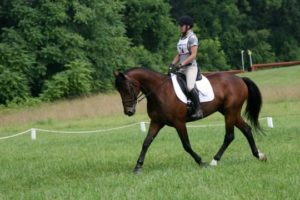
“I trained one really sweet, little horse to become an English hunter horse. Obviously, when I first got on him, he wasn’t super-confident. He didn’t want to do anything wrong. He was a little bit chickenish about walking over ground poles because he didn’t understand the concept,” says Allison-Goodell.
“I had to keep after him, gently urging him forward until he walked over the ground pole. I praised him and patted and rubbed his neck, telling him, ‘What a good boy! What a good boy!’ By his reaction, you’d think he’d jumped over the moon. You could tell he was pleased with himself by his attitude and energy, like, ‘I AM a good boy!’ After that, he took right to it.”
“We went to this state park nearby that has horse bridges that are barely wider than the horse and are 5-6 feet above a creek. He walked over the bridge with no hesitation. He’ll be great for obstacles and trail riding.”
“I’ve built solid relationships from taking turnouts over the years, so there’s trust. It’s nice to kind of have the latitude to say, ‘I’m going to see what your horse wants to do next. I’ll start the horse in the arena and give him options to see what he’d like to do. For Kai Hanover, I found a home for him right before Christmas. He’s making a little girl very happy.”
Across the commonwealth, Pennsylvania’s equine community is working hoof-in-hand to ensure the health, happiness, and overall well being of horses. From a foal’s first steps to the psychological needs of competitive racehorses on and off the track, the needs of the horses’ mind, body, and spirit are navigated to guarantee a happy horse.
Meet Investor at the Horse World Expo!
Meet Investor and several other retired Standardbred horses that are excelling in new careers such as barrel racing, dressage, jumping, and other disciplines. Stop by to visit at the Horse World Expo at the Pennsylvania Farm Show Complex in Harrisburg, PA! The Expo runs February 27th 2020 through March 1st 2020. Tickets & https://www.horseworldexpo.com/
_____
Follow Julie Goodell-Allison: Facebook@ Chestnut Lane Farm
Special thanks to Vicki Wright for Investor photos.
Follow Vicki Wright Photography: Facebook@Vicki Wright Photos
